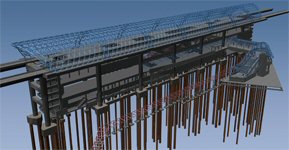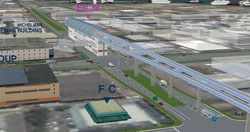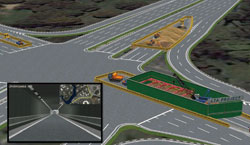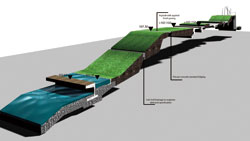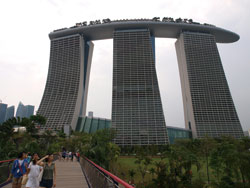To improve the productivity of the construction industry, the Building and Construction Authority (BCA) of Singapore is actively promoting the use of BIM and is gradually making it mandatory to use electronic application using BIM for building permits over a three-year period starting in 2013. In 2015, all buildings over 5000 square meter floor space will be required to be submitted electronically with BIM models for design, structure, and equipment. As a result, the goal of the government is to make BIM popular among 80% of designers and builders by 2015.
Swee Hong saw the government-led introduction of BIM as a positive opportunity for them and started to actively introduce BIM about three years ago.
| Uses Allplan for BIM Model Creation and UC-win/Road for Realistic Presentation |
As the software for creating BIM models, they are using Allplan, a 3D civil engineering and construction CAD software from Nemetschek Allplan in Germany. They also use "Advance Steel" from Graitec in France for the detailed design of the steel structure, "Allplan Precast" from Nemetschek Allplan for framework design and quantity calculation, and FORUM8's 3D real-time VR software "UC-win/Road" for presentations.
In addition, they carefully select and use a variety of software such as "SketchUp" for landscape studies, "iTWO" for examination of construction procedure, and "Maya" and "3ds Max" for creation of computer graphics (CG) and video.
They are conscious of cooperating the BIM model data created in Allplan to these software programs above through IFC and DWG formats. Along with the introduction of BIM software, we have created an organizational structure that supports BIM and an internal workflow.
Mr. Kenneth Lim, the company's assistant director, explains "The cost to implement BIM was about S$1 million, including hardware, software and training. We started using BIM in earnest in 2009".
The year 2009 was said to be the first year of BIM in Japan, and the number of architectural design firms and construction companies introducing BIM increased rapidly from that year. Swee Hong's BIM history is almost the same as those of these companies.
However, perhaps because of the awareness that BIM is positioned as a tool for the entire company and that it should be introduced to increase productivity, they have already realized a wide range of BIM applications, from estimates and presentations in construction bidding to detailed design and construction planning.
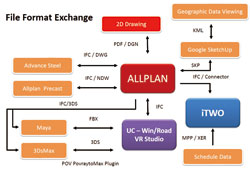 |
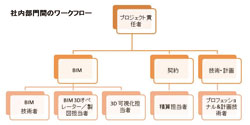 |
| £Data linkage diagram of the BIM software being used (Provided by Swee Hong) |
£Workflow between internal departments based on the use of BIM (Provided by Swee Hong) |
| BIM Is Still Developing in Singapore. 3D Models Can Also Be Created from PDF Drawings. |
2D drawings are currently the mainstream in the civil engineering field in Singapore. For example, when Swee Hong participates in the bidding process for the construction of high-speed railroad stations and viaducts, the client provides PDF data of 2D drawings created by construction consultants.
Based on these PDF drawings, Swee Hong creates a 3D BIM model from the pre-bid preparation stage to efficiently carry out detailed design, estimation, and construction planning for the rebar.
"At present, we often receive design information in the form of 2D drawings rather than BIM models. We create BIM models based on the 2D drawings, and then link the BIM models with various software to plan reinforcement, formwork, and temporary construction plans, as well as to study construction procedures," says Mr. Kenneth Lim.
Instead of waiting for construction consultants, who are located in the upstream of the construction process, to introduce BIM, Swee Hong's style is to proactively build BIM models as a contractor's standpoint to improve productivity in subsequent operations.
Swee Hong also used this method to bid for the construction of an urban rail system in Singapore. The first step in bidding for the 1.8km section, which consists of two 175m-long stations and a double-track viaduct with a maximum span of 40m, was to convert the PDF drawings into BIM models.
Even at the pre-bidding stage, each member of the BIM model was input with "attribute information" such as material, member name and number, dimensions, volume, etc. Detailed reinforcement design was carried out using various software, and quantity calculations for reinforcing steel, concrete, formwork, etc., as well as studies of construction procedures were efficiently processed.
| Importing BIM Models into UC-win/Road for Realistic Presentation of the Construction Site |
The BIM model created was also transferred to "UC-win/Road". Construction procedures and traffic regulations around the construction site were represented in VR, and problems during construction were examined from various viewpoints such as drivers, pedestrians, and the area around the site.
The traffic regulations were reviewed, taking into consideration the areas where visibility would be reduced by the temporary fence boards at the site, and the sense of oppression from the driver's perspective. The visibility from drivers and the scenery during construction were then examined in detail, and an optimal plan was proposed to the client.
Mr. Lim and his team also presented a series of their work using BIM at the "FORUM8 Design Festival 2012-3Days" held in Shinagawa, Tokyo from September 19 to 21, 2012. Their presentation attracted a lot of attention from the many visitors at the venue.
In this way, after fully utilizing BIM and preparing for bidding, Swee Hong effectively made presentations to the client using BIM and VR, and as a result, successfully won the order for construction.
Swee Hong is using a method to utilize BIM models to prepare bids, detailed design, and VR presentations in various projects.
For example, for the construction to expand the Nicoll Highway that runs beside the Sports Hub, a national stadium under construction in downtown Singapore, they used VR to simulate what the road would look like after the construction was completed, and how it would look from the drivers going through the underpass.
When Swee Hong introduced BIM, they reviewed their internal workflows and procedures to ensure smooth operations from bidding to construction. Employee training is one of them; they needed to encourage their employees to use BIM, and to take the time to train them on the new work procedures and BIM.
Swee Hong's commitment to BIM is regarded as one of the most notable in Singapore. The BCA publishes a construction magazine called "build smart", which featured the company in its December 2011 issue.
"Investment in BIM means time savings and leads to future cost savings. Each company's organizational structure, culture, target market, and business processes are different. Especially for civil engineering companies, there is no one-size-fits-all approach to BIM implementation," commented Mr. Lim in the article.
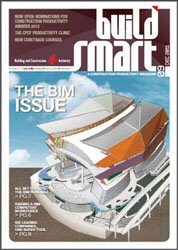 |
| £"build smart" published by BCA. The cover of the December 2011 issue, which featured BIM. |
| BIM Was Also Greatly Utilized in the Construction of Singapore's New Landmark, Gardens by the Bay |
Marina Bay Suns, known for a hotel with a rooftop pool, has become a new tourist attraction in Singapore. On the sea side of it, a vast 55-hectare park called "Gardens by the Bay" is under improvement work until 2020.
Swee Hong was the prime contractor for the work of the central part of the park, which is already open, and is still working on several sections of the park, including project management, mechanical equipment, landscape design, architecture, and civil works such as roads. BIM is also playing an important role in this construction.
For example, in order to express the height and location of undulating terrain and water surfaces in an easy-to-understand manner, they created a cut model of the ground from the BIM model, making the most of the benefits of visualization.
Singapore is a leading BIM country in Asia, and the use of BIM is spreading not only in buildings but also in civil engineering structures such as roads and railroads. Swee Hong's efforts to steadily introduce BIM while linking data between Allplan and UC-win/Road will be helpful for Japanese construction companies to introduce CIM (Construction Information Modeling).
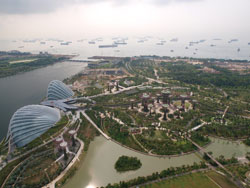 |
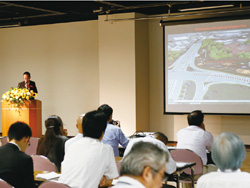 |
| £Gardens by the Bay as seen from Marina Bay Suns, which will be under improvement work until 2020. |
£Mr. Kenneth Lim, Swee Hong's assistant director gave a lecture at the architecture and BIM session of FORUM8 Design Festival 2012. |
(Translation of the article written and interviewed by Mr. Ryota Ieiri, Ieiri Labo)
